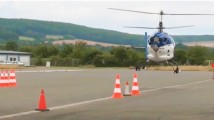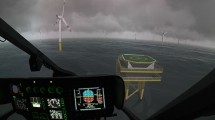Abstract
This paper discusses a possible solution to allow rapid prototyping of augmented reality content for evaluating user assistance systems. Building upon current approaches from the automotive context, it presents options to transfer these to the aerospace context, focusing on upcoming electric Vertical Take-Off and Landing aircraft. By showing issues of using optical-see-through glasses inside a moving simulator, a solution for using video-see-through head-mounted displays instead is presented. As a solution, a modular system setup that can handle different rendering sources to create contact-analog augmentations on top of a virtual environment while using video-see-through capabilities to interact with the physical cockpit environment is presented. The main contribution is a process to avoid manual calibration between the different coordinate systems across the involved applications. To further discuss holographic content for vehicle-based augmentations, a first taxonomy is discussed on locating augmentations to prototype such concepts with the presented Mixed-Reality-Simulator.
S. Liedtke and M. Zintl—contributed equally to this work
Supported by “Bayerisches Staatsministerium für Wirtschaft, Landesentwicklung und Energie”

Access this chapter
Tax calculation will be finalised at checkout
Purchases are for personal use only
Similar content being viewed by others
Notes
- 1.
https://varjo.com/products/xr-3/ (accessed on 15 May 2023).
- 2.
https://www.x-plane.com/ (accessed on 15 May 2023).
- 3.
https://github.com/openvrmc/ (Accessed 15 May 2023).
References
Barbosa, S., et al. (eds.): Elements of XR prototyping: characterizing the role and use of prototypes in augmented and virtual reality design. ACM, New York (2022). https://doi.org/10.1145/3491102
Echtler, F., Huber, M.J., Pustka, D., Keitler, P., Klinker, G.: Splitting the scene graph. In: Proceedings of the International Conference on Computer Graphics Theory and Applications (GRAPP), pp. 456–459. INSTICC, Funchal, Madeira (2008)
Ernst, J.M., Laudien, T., Schmerwitz, S.: Implementation of a mixed-reality flight simulator: blending real and virtual with a video-see-through head-mounted display. In: Solomon, L., Schwartz, P.J. (eds.) Artificial Intelligence and Machine Learning for Multi-Domain Operations Applications V, vol. 12538, p. 125380R. International Society for Optics and Photonics, SPIE (2023). https://doi.org/10.1117/12.2664848
Haiduk, P.M.: Display formats for smart glasses to support pilots in general aviation. Ph.D. thesis, Technische Universität Darmstadt, Darmstadt, Germany (2017)
Milgram, P., Kishino, F.: A taxonomy of mixed reality visual displays. IEICE Trans. Inf. Syst. E77-D(12), 1321–1329 (1994)
Pierdicca, R., Frontoni, E., Pollini, R., Trani, M., Verdini, L.: The use of augmented reality glasses for the application in industry 4.0. In: De Paolis, L.T., Bourdot, P., Mongelli, A. (eds.) AVR 2017. LNCS, vol. 10324, pp. 389–401. Springer, Cham (2017). https://doi.org/10.1007/978-3-319-60922-5_30
Poitschke, T., Ablassmeier, M., Rigoll, G., Bardins, S., Kohlbecher, S., Schneider, E.: Contact-analog information representation in an automotive head-up display. In: Proceedings of the 2008 Symposium on Eye Tracking Research & Applications, ETRA ’08, pp. 119–122. Association for Computing Machinery, New York (2008). https://doi.org/10.1145/1344471.1344502
Schneider, M., Bruder, A., Necker, M., Schluesener, T., Henze, N., Wolff, C.: A real-world driving experiment to collect expert knowledge for the design of AR HUD navigation that covers less. In: Mensch und Computer 2019 - Workshopband. Gesellschaft fur Informatik E.V., Bonn (2019). https://doi.org/10.18420/muc2019-ws-610
Lavie, T., Meyer, J.: Benefits and costs of adaptive user interfaces. Int. J. Hum Comput Stud. 68(8), 508–524 (2010). https://doi.org/10.1016/j.ijhcs.2010.01.004
Tönnis, M.: Towards automotive augmented reality. Dissertation, Technische Universität München (2008)
Tönnis, M., Plecher, D.A., Klinker, G.: Representing information-classifying the augmented reality presentation space. Comput. Graph. 37(8), 997–1011 (2013)
Tuceryan, M., Navab, N.: Single point active alignment method (SPAAM) for optical see-through HMD calibration for AR. In: Proceedings IEEE and ACM International Symposium on Augmented Reality (ISAR 2000), pp. 149–158 (2000). https://doi.org/10.1109/ISAR.2000.880938
Viertler, F.: Visual augmentation for rotorcraft pilots in degraded visual environment. Ph.D. thesis (2017)
Walko, C., Schuchardt, B.: Increasing helicopter flight safety in maritime operations with a head-mounted display. CEAS Aeronaut. J. 12(1), 29–41 (2021)
Wiesner, C.A.: Increasing the maturity of the augmented reality head-up-display. Dissertation, Technische Universität München (2019)
Wiesner, C.A., Ruf, M., Sirim, D., Klinker, G.: 3D-FRC: depiction of the future road course in the head-up-display. In: 2017 IEEE International Symposium on Mixed and Augmented Reality (ISMAR), pp. 136–143 (2017). https://doi.org/10.1109/ISMAR.2017.30
Zintl, M., Marb, M., Wechner, M., Seiferth, D., Holzapfel, F.: Development of a virtual reality simulator for eVTOL flight testing. In: AIAA Aviation Forum 2022 (2022). https://doi.org/10.2514/6.2022-3941
Author information
Authors and Affiliations
Corresponding author
Editor information
Editors and Affiliations
Rights and permissions
Copyright information
© 2023 The Author(s), under exclusive license to Springer Nature Switzerland AG
About this paper
Cite this paper
Liedtke, S., Zintl, M., Holzapfel, F., Klinker, G. (2023). A Mixed Reality Setup for Prototyping Holographic Cockpit Instruments. In: Zachmann, G., et al. Virtual Reality and Mixed Reality. EuroXR 2023. Lecture Notes in Computer Science, vol 14410. Springer, Cham. https://doi.org/10.1007/978-3-031-48495-7_5
Download citation
DOI: https://doi.org/10.1007/978-3-031-48495-7_5
Published:
Publisher Name: Springer, Cham
Print ISBN: 978-3-031-48494-0
Online ISBN: 978-3-031-48495-7
eBook Packages: Computer ScienceComputer Science (R0)




